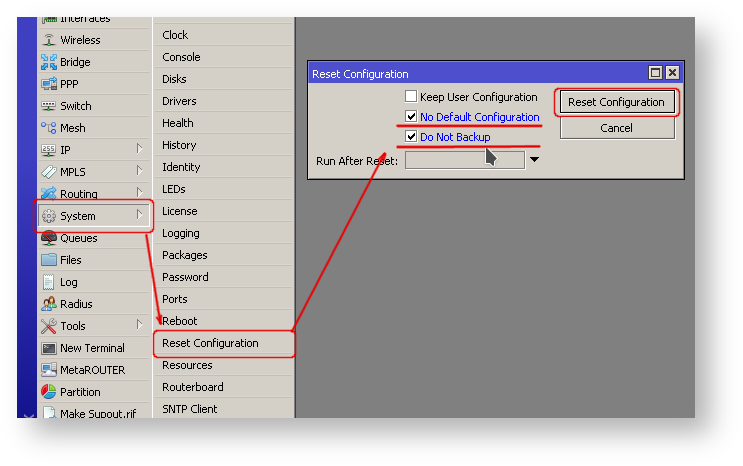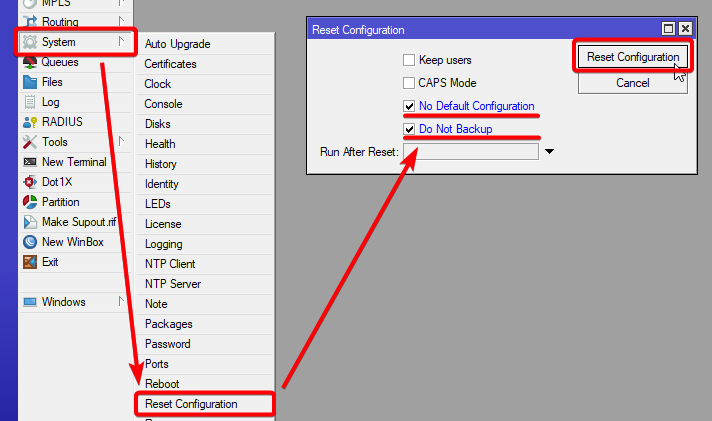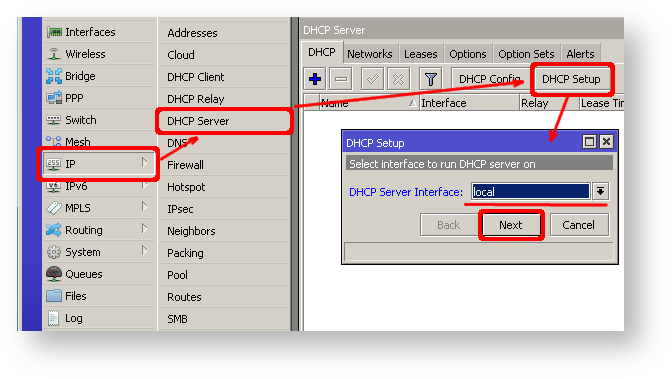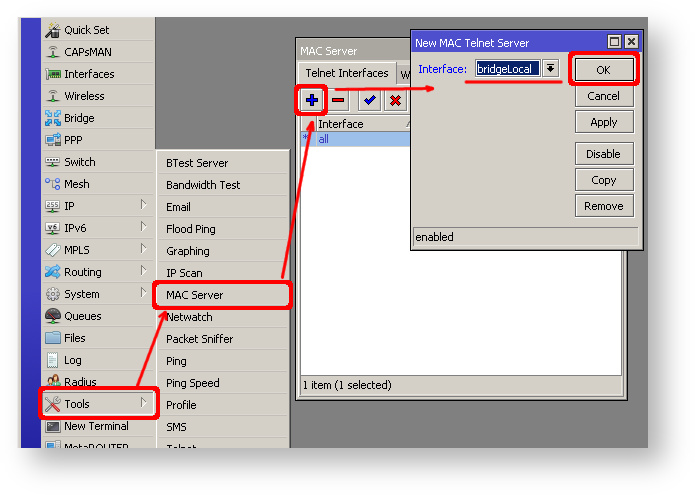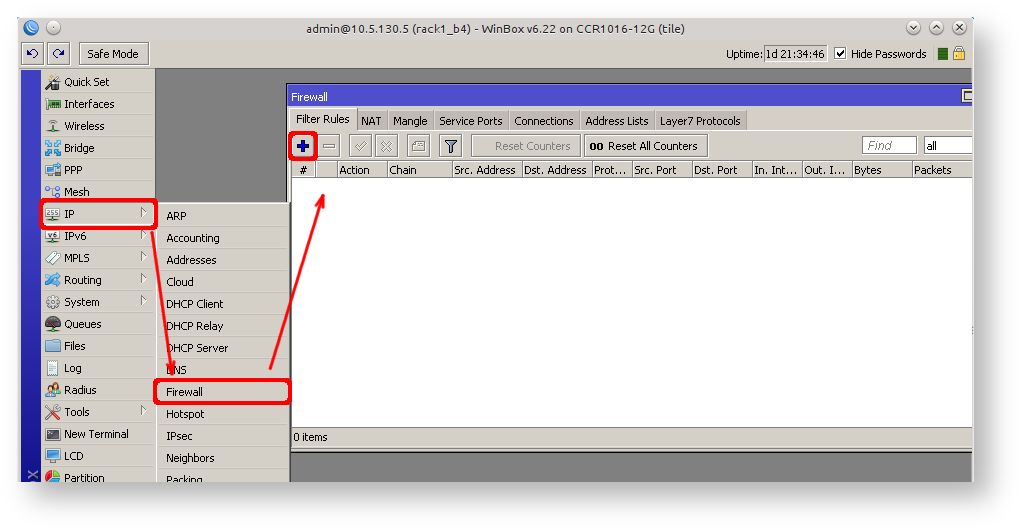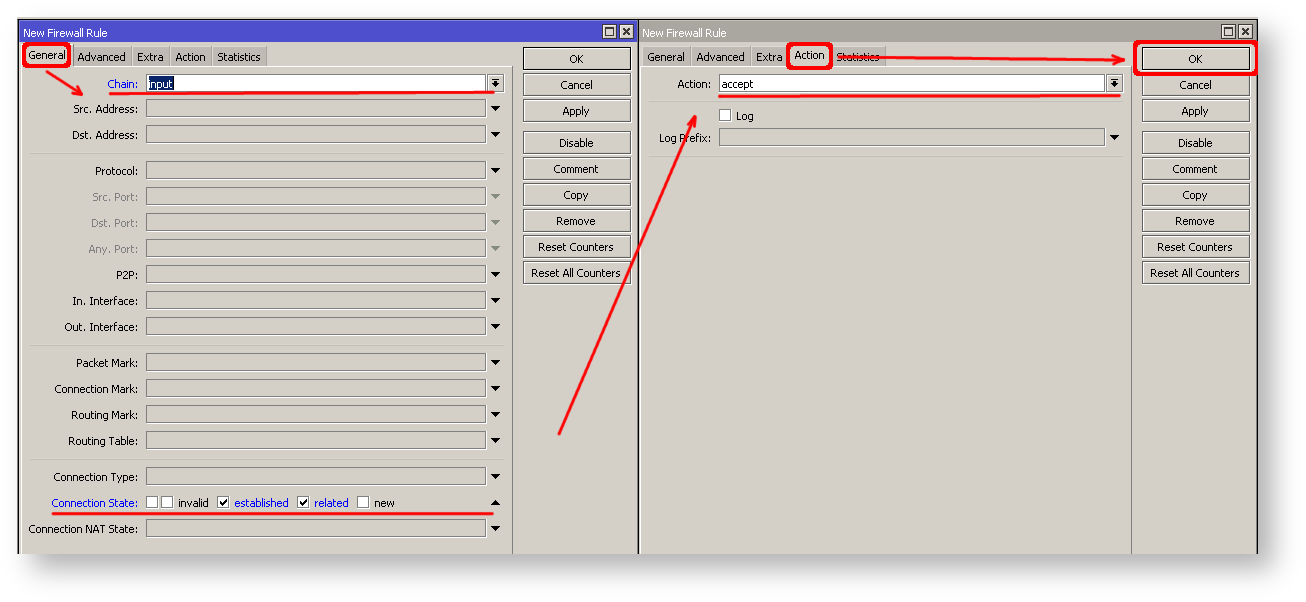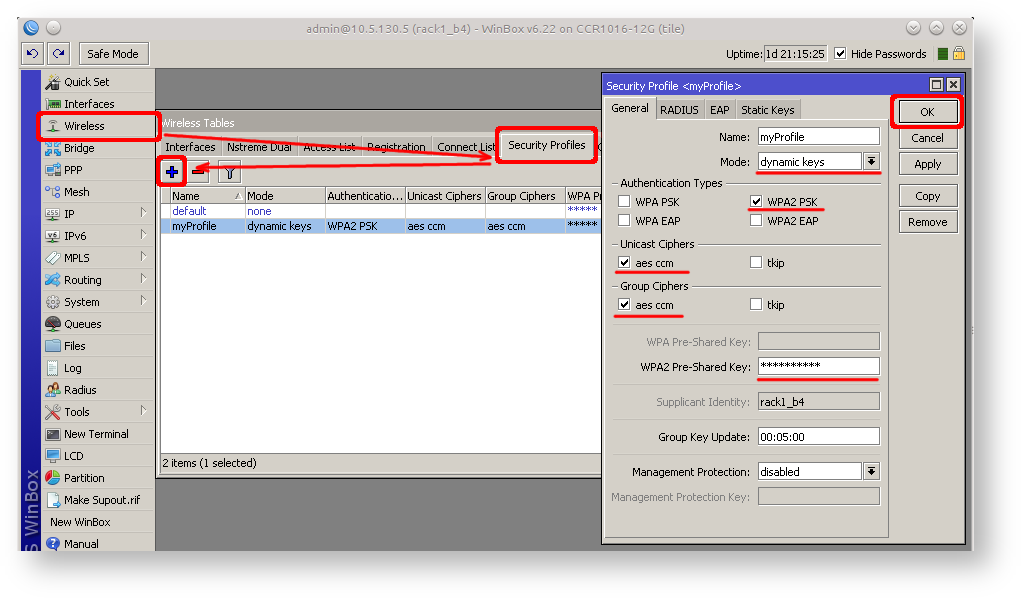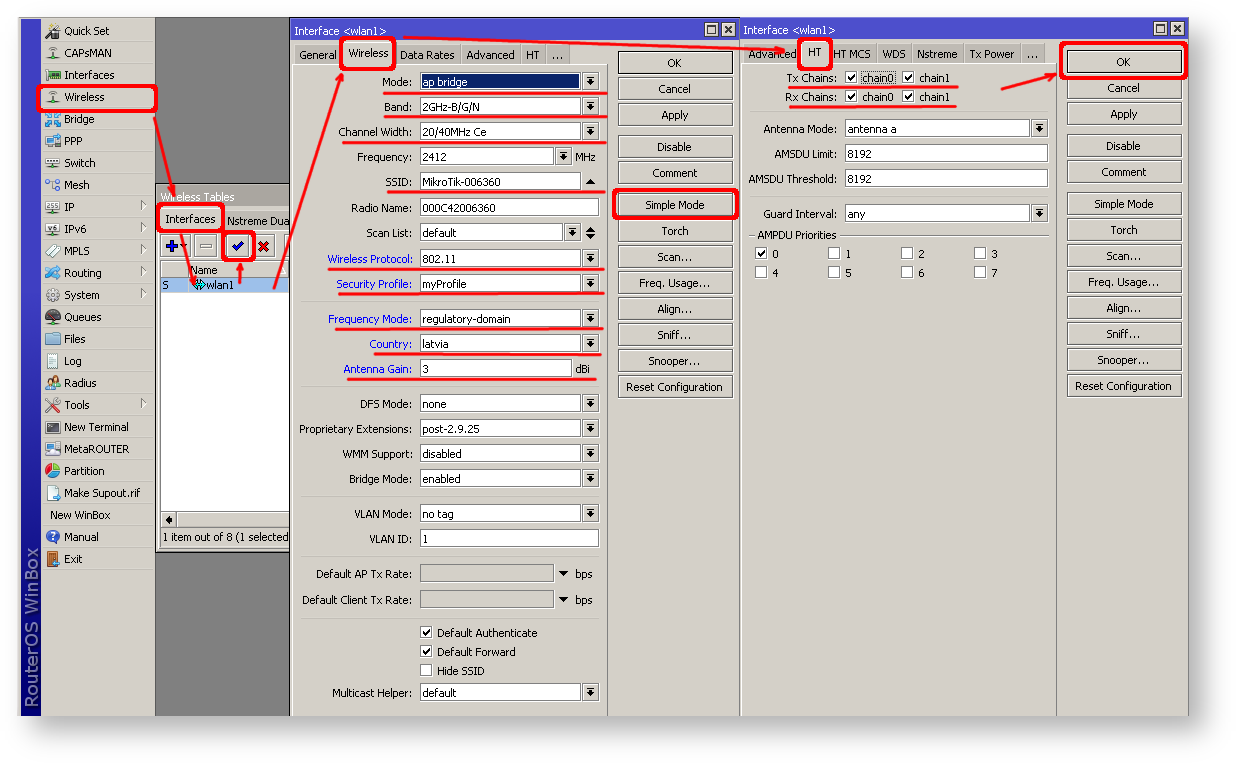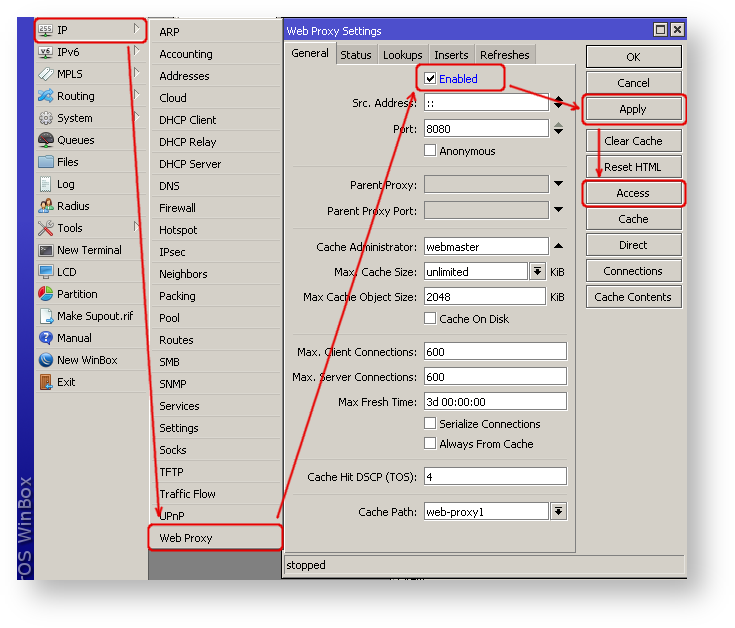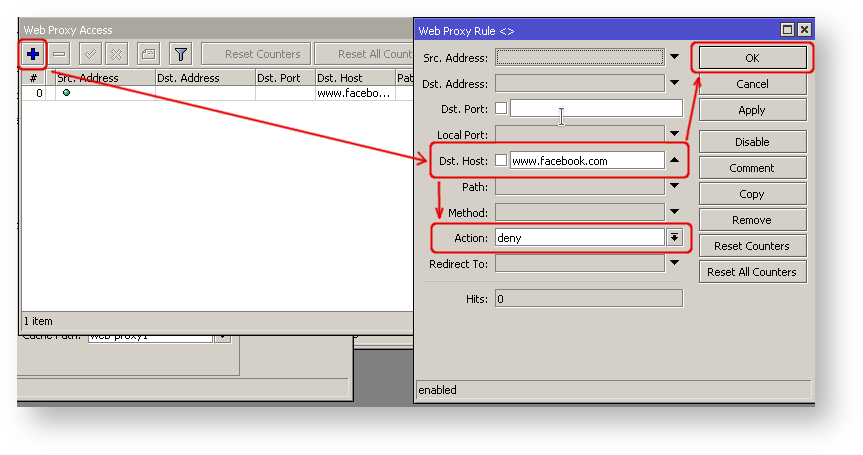...
| title | On this page: |
|---|
| Table of Contents |
|---|
Connecting to the Router
There are two types of routers:
...
- Routers with default configuration.
...
- Routers without default configuration.
...
- In cases where no specific configuration is
...
- present, the IP address 192.168.88.1/24 is
...
- assigned to ether1
...
- , combo1, sfp1, or
...
- MGMT/BOOT.
...
For additional details regarding the current default configuration
...
, please refer to the Quick Guide document
...
provided with your device.
...
This document outlines which ports
...
to
...
initially utilize for connection and instructions on device setup.
This document describes
...
the step-by-step process for configuring the device from
...
scratch. Therefore, we recommend clearing all defaults when initiating the setup.
When connecting the first time to the router with the default username admin and no password (or, for some models, check user and wireless passwords on the sticker). Upon the initial boot, a notification will appear, offering you
...
the choice to either remove the default configuration (even if the default config
...
has only an IP address), leading to a reboot with no configuration applied, or to "Show Script" and retain the current default configuration, applying it accordingly. Since this article assumes that there is no configuration on the router, you should remove it by pressing "r" on the keyboard when prompted or click on the "Remove
...
Configuration" button in
...
WinBox.
Router without Default Configuration
If
...
the router
...
doesn't have a default configuration, there are multiple options to consider. However, in this case, we'll opt for a method that best fits our requirements.
Connect the ISP cable to the router's ether1 port and connect your PC to
...
any port except ether1. Then, launch WinBox and search for your router
...
using the neighbor discovery feature. See detailed example in
...
If
...
the router appears in the list,
...
select its MAC address and click Connect.
...
The easiest method to ensure a completely clean router is to run the CLI command
| Code Block | ||
|---|---|---|
|
...
...
/system reset-configuration no-defaults=yes skip-backup=yes |
...
| Section |
|---|
...
| border | true |
|---|
Or from WinBox (Fig. 1-1):
|
...
Configuring IP Access
...
As MAC connection
...
can sometimes be unreliable, our first step is to configure the router to enable IP connectivity:
- Create a bridge interface and assign
...
- bridge ports;
...
- Assign an IP address to
...
- the bridge interface;
...
- Configure a DHCP server.
...
Setting up the bridge and assigning an IP address
...
are straightforward processes:
| Code Block | ||
|---|---|---|
|
...
/interface |
...
/bridge |
...
/add name= |
...
bridge1 /interface |
...
/bridge |
...
/port add interface=ether2 bridge= |
...
bridge1 /ip |
...
/address |
...
/add address=192.168.88.1/24 interface= |
...
bridge1 |
If you prefer
...
WinBox/
...
WeBfig as configuration tools:
| Section |
|---|
...
|
...
|
...
|
...
|
...
|
...
|
...
| Section |
|---|
...
|
...
|
...
|
...
|
...
|
...
|
...
|
Next
...
, proceed with setting up a DHCP server. To simplify and expedite this process, we'll execute the setup command.
| Code Block | |
|---|---|
|
...
| |
[admin@MikroTik] > ip/ |
...
dhcp-server/ setup [enter] Select interface to |
...
run DHCP server on |
...
dhcp server interface: |
...
bridge1 [enter] |
...
Select network for DHCP addresses |
...
dhcp address space: 192.168.88.0/24 [enter]
|
...
Select gateway for given network |
...
gateway for dhcp network: 192.168.88.1 [enter]
|
...
Select pool of ip addresses given out by DHCP server |
...
addresses to give out: 192.168.88.2-192.168.88.254 [enter]
|
...
Select DNS servers |
...
dns servers: 192.168.88.1 [enter] |
...
Select lease time |
...
lease time: |
...
1800 [enter] |
Notice that most of the configuration options are automatically determined and you just simply need to hit the enter key.
| Section |
|---|
...
...
The |
...
setup tool is also |
...
accessible in |
...
WinBox/ |
...
WebFig:
|
...
|
...
|
...
|
...
|
...
|
...
|
...
...
Following these steps, the connected PC should
...
now obtain a dynamic IP address.
...
You can then close Winbox and reconnect to the router using the IP address (192.168.88.1).
Configuring Internet Connection
...
To enable internet access for the router, you'll need to
...
configure one of the following common types of internet connections
...
:
...
- Dynamic public IP address
...
- .
...
- Static public IP address
...
- .
- PPPoE connection.
Dynamic Public IP
Dynamic address configuration is the
...
easiest option. Simply set up a DHCP client on the public interface. The DHCP client will
...
obtain information from
...
your Internet Service Provider (ISP)
...
, such as an IP address, DNS servers, NTP servers, and default route
...
, making the setup process straightforward for you.
| Code Block | ||
|---|---|---|
|
...
/ip dhcp-client add disabled=no interface=ether1 |
After adding the client you should see the assigned address and status should be bound
| Code Block | |
|---|---|
|
...
| |||
[admin@MikroTik] > ip/ |
...
dhcp- |
...
client/print |
...
Columns: |
...
INTERFACE, USE- |
...
PEER-DNS, ADD-DEFAULT-ROUTE, |
...
STATUS, ADDRESS # |
...
INTERFACE |
...
USE-PEER-DNS |
...
ADD-DEFAULT-ROUTE STATUS ADDRESS |
...
...
0 ether1 |
...
yes |
...
yes |
...
bound |
...
1.2.3.100/24 |
Static Public IP
...
When configuring a static address
...
, your ISP
...
provides specific parameters,
...
such as:
- IP: 1.2.3.100/24
- Gateway: 1.2.3.1
- DNS: 8.8.8.8
These are three basic parameters that you need to get the internet connection working.
To
...
configure this in RouterOS, we
...
'll manually add an IP address, add a default route with a provided gateway, and set up a DNS server
| Code Block | ||
|---|---|---|
|
...
...
/ip |
...
/address |
...
/add address=1.2.3.100/24 interface=ether1 /ip |
...
/route |
...
/add gateway=1.2.3.1 /ip |
...
/dns |
...
/set servers=8.8.8.8 |
PPPoE Connection
PPPoE connection also gives you a dynamic IP address and can configure dynamically DNS and default gateway. Typically service provider (ISP) gives you a username and password for the connection
| Code Block | ||
|---|---|---|
|
...
/interface pppoe-client
add disabled=no interface=ether1 user=me password=123 \
add-default-route=yes use-peer-dns=yes |
| Section |
|---|
...
...
Winbox/Webfig actions:
|
...
|
...
|
...
|
...
|
...
| Note |
|---|
Further in configuration, the WAN interface is now the pppoe- |
...
out1 interface, not ether1. |
Verify Connectivity
...
Once the configuration is complete, you should be able to access the internet from the router.
...
To verify IP connectivity
...
, try pinging a known IP address
...
, such as a Google DNS server
...
.
| Code Block | |
|---|---|
|
...
| |||
[admin@MikroTik] > /ping 8.8.8.8 SEQ HOST SIZE TTL TIME STATUS 0 8.8.8.8 56 55 |
...
14ms399us |
...
1 8.8.8.8 56 |
...
Verify DNS request
...
| language | powershell |
|---|---|
| theme | FadeToGrey |
...
55 18ms534us 2 8.8.8.8 56 55 |
...
14ms384us |
Verify DNS request
| Code Block | ||||
|---|---|---|---|---|
| ||||
[admin@MikroTik] > /ping google.com SEQ HOST |
...
|
...
|
...
SIZE TTL TIME STATUS |
...
|
...
If everything is set up correctly, ping in both cases should not fail.
In case of failure refer to troubleshooting section
Protecting the Router
Now anyone over the world can access our router so it is best time to protect it from intruders and basic attacks
User Password Access
| Code Block | ||||
|---|---|---|---|---|
| ||||
[admin@MikroTik] > / password
old password:
new password: ******
retype new password: ****** |
This command will change your current admin's password to what you have entered twice. Make sure you remember the password! If you forget it, there is no recovery. You will need to reinstall the router!
You can also add more users with full or limited router access in /user menu
| Tip |
|---|
Best practice is to add new user with strong password and disable default admin user. |
MAC Connectivity Access
By default mac server runs on all interfaces, so we will disable default all entry and add only local interface to disallow MAC connectivity from WAN port.
| Code Block | ||||
|---|---|---|---|---|
| ||||
[admin@MikroTik] /tool mac-server> print
Flags: X - disabled, * - default
# INTERFACE
0 * all |
| Code Block | ||||
|---|---|---|---|---|
| ||||
/tool mac-server
disable 0;
add interface=local; |
Do the same for Winbox MAC access
| Code Block | ||||
|---|---|---|---|---|
| ||||
/tool mac-server mac-winbox
disable 0;
add interface=local; |
...
| border | true |
|---|
Winbox/Webfig actions:
| Column | ||
|---|---|---|
| ||
|
| Column |
|---|
Do the same in Winbox Interface tab to block Mac Winbox connections from the internet
IP Connectivity Access
IP connectivity on public interface also must be limited. We will accept only ICMP(ping/traceroute), IP winbox and ssh access.
| Code Block | ||||||
|---|---|---|---|---|---|---|
| ||||||
/ip firewall filter
add chain=input connection-state=established,related action=accept comment="accept established,related";
add chain=input connection-state=invalid action=drop;
add chain=input in-interface=ether1 protocol=icmp action=accept comment="allow ICMP";
add chain=input in-interface=ether1 protocol=tcp port=8291 action=accept comment="allow Winbox";
add chain=input in-interface=ether1 protocol=tcp port=22 action=accept comment="allow SSH";
add chain=input in-interface=ether1 action=drop comment="block everything else"; |
| Warning |
|---|
In case if public interface is pppoe, then in-interface should be set to "pppoe-out". |
First two rules accepts packets from already established connections, so we assume those are OK to not overload the CPU. The third rule drops any packet which connection tracking thinks is invalid. After that we set up typical accept rules for specific protocols.
...
| border | true |
|---|
If you are using Winbox/webfig for configuration, here is an example on how to add established/related rule:
| Column | ||
|---|---|---|
| ||
|
| Column |
|---|
To add other rules click on + for each new rule and fill the same parameters as provided in console example.
NAT Configuration
At this point PC is not yet able to access the Internet, because locally used addresses are not rout-able over the Internet. Remote hosts simply does not know how to correctly reply to your local address.
Solution for this problem is change the source address for outgoing packets to routers public IP. This can be done with NAT rule:
| Code Block | ||||
|---|---|---|---|---|
| ||||
/ip firewall nat
add chain=srcnat out-interface=ether1 action=masquerade |
| Warning |
|---|
In case if public interface is pppoe, then in-interface should be set to "pppoe-out". |
Another benefit of such setup is that NATed clients behind the router are not directly connected to the Internet, that way additional protection against attacks from outside mostly is not required.
Port Forwarding
Some client devices may need direct access to the internet over specific ports. For example, client with IP address 192.168.88.254 must be accessible by Remote desktop protocol (RDP).
After quick search on Google we find out that RDP runs on TCP port 3389. Now we can add destination NAT rule to redirect RDP to the clients PC.
| Code Block | ||||
|---|---|---|---|---|
| ||||
/ip firewall nat
add chain=dstnat protocol=tcp port=3389 in-interface=ether1 \
action=dst-nat to-address=192.168.88.254 |
...
Setting up Wireless
For ease of use bridged wireless setup will be made, so that your wired hosts are in the same Ethernet broadcast domain as wireless clients.
Important part is to make sure that our wireless is protected, so the first step is security profile.
Security profiles are configured from /interface wireless security-profiles menu in terminal.
| Code Block | ||||
|---|---|---|---|---|
| ||||
/interface wireless security-profiles
add name=myProfile authentication-types=wpa2-psk mode=dynamic-keys \
wpa2-pre-shared-key=1234567890 |
...
| border | true |
|---|
in Winbox/Webfig click on Wireless to open wireless windows and choose Security Profile tab.
| Column |
|---|
If there are legacy devices which do not support WPA2 (like Windows XP), you may also want to allow WPA protocol.
| Warning |
|---|
WPA and WPA2 pre-shared keys should not be the same. |
Now when security profile is ready we can enable wireless interface and set desired parameters
| Code Block | ||||
|---|---|---|---|---|
| ||||
/interface wireless
enable wlan1;
set wlan1 band=2ghz-b/g/n channel-width=20/40mhz-Ce distance=indoors \
mode=ap-bridge ssid=MikroTik-006360 wireless-protocol=802.11 \
security-profile=myProfile frequency-mode=regulatory-domain \
set country=latvia antenna-gain=3 |
...
| border | true |
|---|
To do the same from Winbox/Webfig:
| Column | ||
|---|---|---|
| ||
|
| Column |
|---|
Last step is to add wireless interface to local bridge, otherwise connected clients will not get an IP address:
| Code Block | ||||
|---|---|---|---|---|
| ||||
/interface bridge port
add interface=wlan1 bridge=local |
...
Protecting the Clients
Now it is time to add some protection for clients on our LAN. We will start with basic set of rules.
| Code Block | ||||
|---|---|---|---|---|
| ||||
/ip firewall filter
add chain=forward action=fasttrack-connection connection-state=established,related \
comment="fast-track for established,related";
add chain=forward action=accept connection-state=established,related \
comment="accept established,related";
add chain=forward action=drop connection-state=invalid
add chain=forward action=drop connection-state=new connection-nat-state=!dstnat \
in-interface=ether1 comment="drop access to clients behind NAT form WAN" |
...
The last rule drops all new connection attempts from WAN port to our LAN network (unless dstnat is used). Without this rule if attacker knows or guesses your local subnet, he/she can establish connections directly to local hosts and cause security threat.
For ease of rule management we will add several new chains and jump rules:
| Code Block | ||||
|---|---|---|---|---|
| ||||
/ip firewall filter
add chain=forward action=jump jump-target=bogons
add chain=forward protocol=tcp action=jump jump-target=tcp
add chain=forward protocol=udp action=jump jump-target=udp
add chain=forward protocol=icmp action=jump jump-target=icmp |
Chain "bogons" drops all connection attempts from/to bogon addresses:
| Code Block | ||||
|---|---|---|---|---|
| ||||
/ip firewall filter
add chain=bogons src-address=0.0.0.0/8 action=drop
add chain=bogons dst-address=0.0.0.0/8 action=drop
add chain=bogons src-address=127.0.0.0/8 action=drop
add chain=bogons dst-address=127.0.0.0/8 action=drop
add chain=bogons src-address=224.0.0.0/3 action=drop
add chain=bogons dst-address=224.0.0.0/3 action=drop |
Create "tcp" chain and deny some TCP ports in it:
| Code Block | ||||
|---|---|---|---|---|
| ||||
/ip firewall filter
add chain=tcp protocol=tcp dst-port=69 action=drop \
comment="deny TFTP"
add chain=tcp protocol=tcp dst-port=111 action=drop \
comment="deny RPC portmapper"
add chain=tcp protocol=tcp dst-port=135 action=drop \
comment="deny RPC portmapper"
add chain=tcp protocol=tcp dst-port=137-139 action=drop \
comment="deny NBT"
add chain=tcp protocol=tcp dst-port=445 action=drop \
comment="deny cifs"
add chain=tcp protocol=tcp dst-port=2049 action=drop comment="deny NFS"
add chain=tcp protocol=tcp dst-port=12345-12346 action=drop comment="deny NetBus"
add chain=tcp protocol=tcp dst-port=20034 action=drop comment="deny NetBus"
add chain=tcp protocol=tcp dst-port=3133 action=drop comment="deny BackOriffice"
add chain=tcp protocol=tcp dst-port=67-68 action=drop comment="deny DHCP" |
Deny UDP ports in "udp" chain:
| Code Block | ||||
|---|---|---|---|---|
| ||||
/ip firewall filter
add chain=udp protocol=udp dst-port=69 action=drop comment="deny TFTP"
add chain=udp protocol=udp dst-port=111 action=drop comment="deny PRC portmapper"
add chain=udp protocol=udp dst-port=135 action=drop comment="deny PRC portmapper"
add chain=udp protocol=udp dst-port=137-139 action=drop comment="deny NBT"
add chain=udp protocol=udp dst-port=2049 action=drop comment="deny NFS"
add chain=udp protocol=udp dst-port=3133 action=drop comment="deny BackOriffice" |
Allow only needed icmp codes in "icmp" chain:
...
| language | ros |
|---|---|
| linenumbers | true |
...
0 142.250.74.14 56 55 14ms475us
1 142.250.74.14 56 55 14ms308us
2 142.250.74.14 56 55 14ms238us |
If all settings are configured correctly, both pings should succeed.
If there's a failure, please refer to the Troubleshooting section for assistance.
Protecting the Router
As the router is now accessible worldwide, it's important to protect it from potential intruders and basic attacks.
User Password Access
For MikroTik routers, it's essential to set up passwords. We recommend using a password generator tool to create robust passwords that meet the following criteria:
- At least 12 characters long;
- Consist of numbers, symbols, uppercase, and lowercase letters;
- Avoid using dictionary words or combinations thereof.
| Code Block | ||
|---|---|---|
| ||
/user set 0 password="!={Ba3N!40TуX+GvKBzjTLIUcx/," |
Another method to set a password for the current user:
| Code Block | ||
|---|---|---|
| ||
/password |
We highly recommend using a secondary method or the Winbox interface to update your router's password, as an added measure to safeguard against unauthorized access.
| Code Block | ||||
|---|---|---|---|---|
| ||||
[admin@MikroTik] > /password
old-password: ***
new-password: ****************************
confirm-new-password: **************************** |
Ensure you remember the password! If it's forgotten, there's no way to recover it. You'll have to reset the configuration or reinstall the router system!
You can also add additional users with full or limited router access in the /user menu
| Tip |
|---|
The best practice is to create a new user with a strong password and disable or remove the default admin user. |
| Code Block | ||
|---|---|---|
| ||
/user add name=myname password=mypassword group=full
/user remove admin |
| Info |
|---|
| Note: Log in to the router using the new credentials to verify that the username and password are functioning correctly. |
MAC Connectivity Access
By default, the MAC server runs on all interfaces. To restrict MAC connectivity from the WAN port, we'll disable the default all entry and add a LAN interface.
First, create an interface list:
| Code Block | ||
|---|---|---|
| ||
[admin@MikroTik] > /interface list add name=LAN |
Then, add your previously created bridge named "bridge1" to the interface list:
| Code Block | ||
|---|---|---|
| ||
[admin@MikroTik] > /interface list member add list=LAN interface=bridge1 |
Apply newly created "list" (of interfaces) to the MAC server:
| Code Block | ||
|---|---|---|
| ||
[admin@MikroTik] > /tool mac-server set allowed-interface-list=LAN |
Do the same for Winbox MAC access
| Code Block | ||
|---|---|---|
| ||
[admin@MikroTik] > /tool mac-server mac-winbox set allowed-interface-list=LAN |
| Section | |||||||
|---|---|---|---|---|---|---|---|
Winbox/Webfig actions:
|
Do the same in the MAC Winbox Server tab to block Mac Winbox connections from the internet.
Neighbor Discovery
MikroTik Neighbor discovery protocol is used to show and recognize other MikroTik routers in the network. Disable neighbor discovery on public interfaces:
| Code Block | ||
|---|---|---|
| ||
/ip neighbor discovery-settings set discover-interface-list=listBridge |
IP Connectivity Access
Besides the fact that the firewall protects your router from unauthorized access from outer networks, it is possible to restrict username access for the specific IP address
| Code Block | ||
|---|---|---|
| ||
/user set 0 allowed-address=x.x.x.x/yy |
x.x.x.x/yy - your IP or network subnet that is allowed to access your router.
IP connectivity on the public interface must be limited in the firewall. We will accept only ICMP(ping/traceroute), IP Winbox, and ssh access.
| Code Block | ||||
|---|---|---|---|---|
| ||||
/ip firewall filter
add chain=input connection-state=established,related action=accept comment="accept established,related";
add chain=input connection-state=invalid action=drop;
add chain=input in-interface=ether1 protocol=icmp action=accept comment="allow ICMP";
add chain=input in-interface=ether1 protocol=tcp port=8291 action=accept comment="allow Winbox";
add chain=input in-interface=ether1 protocol=tcp port=22 action=accept comment="allow SSH";
add chain=input in-interface=ether1 action=drop comment="block everything else"; |
| Warning |
|---|
In case if a public interface is a pppoe, then the in-interface should be set to "pppoe-out". |
The first two rules accept packets from already established connections, so we assume those are OK to not overload the CPU. The third rule drops any packet which connection tracking thinks is invalid. After that, we set up typical accept rules for specific protocols.
| Section | |||||||
|---|---|---|---|---|---|---|---|
If you are using Winbox/Webfig for configuration, here is an example of how to add an established/related rule:
|
To add other rules click on + for each new rule and fill the same parameters as provided in the console example.
Administrative Services
Although the firewall protects the router from the public interface, you may still want to disable RouterOS services.
Most of RouterOS administrative tools are configured at the /ip service menu
Keep only secure ones,
| Code Block | ||
|---|---|---|
| ||
/ip service disable telnet,ftp,www,api |
Change default service ports, this will immediately stop most of the random SSH brute force login attempts:
| Code Block | ||
|---|---|---|
| ||
/ip service set ssh port=2200 |
Additionally, each service can be secured by allowed IP address or address range(the address service will reply to), although more preferred method is to block unwanted access in firewall because the firewall will not even allow to open socket
| Code Block | ||
|---|---|---|
| ||
/ip service set winbox address=192.168.88.0/24 |
Other Services
A bandwidth server is used to test throughput between two MikroTik routers. Disable it in the production environment.
| Code Block | ||
|---|---|---|
| ||
/tool bandwidth-server set enabled=no |
A router might have DNS cache enabled, which decreases resolving time for DNS requests from clients to remote servers. In case DNS cache is not required on your router or another router is used for such purposes, disable it.
| Code Block | ||
|---|---|---|
| ||
/ip dns set allow-remote-requests=no |
Some RouterBOARDs have an LCD module for informational purposes, set pin or disable it.
| Code Block | ||
|---|---|---|
| ||
/lcd set enabled=no |
It is good practice to disable all unused interfaces on your router, in order to decrease unauthorized access to your router.
| Code Block | ||
|---|---|---|
| ||
/interface print
/interface set x disabled=yes |
Where "X" is a number of the unused interfaces.
RouterOS utilizes stronger crypto for SSH, most newer programs use it, to turn on SSH strong crypto:
| Code Block | ||
|---|---|---|
| ||
/ip ssh set strong-crypto=yes |
Following services are disabled by default, nevertheless, it is better to make sure that none of then were enabled accidentally:
- MikroTik caching proxy,
| Code Block | ||
|---|---|---|
| ||
/ip proxy set enabled=no |
- MikroTik socks proxy,
| Code Block | ||
|---|---|---|
| ||
/ip socks set enabled=no |
- MikroTik UPNP service,
| Code Block | ||
|---|---|---|
| ||
/ip upnp set enabled=no |
- MikroTik dynamic name service or IP cloud,
| Code Block | ||
|---|---|---|
| ||
/ip cloud set ddns-enabled=no update-time=no |
NAT Configuration
At this point, PC is not yet able to access the Internet, because locally used addresses are not routable over the Internet. Remote hosts simply do not know how to correctly reply to your local address.
The solution for this problem is to change the source address for outgoing packets to routers public IP. This can be done with the NAT rule:
| Code Block | ||
|---|---|---|
| ||
/ip firewall nat
add chain=srcnat out-interface=ether1 action=masquerade |
| Warning |
|---|
In case if a public interface is a pppoe, then the out-interface should be set to "pppoe-out". |
Another benefit of such a setup is that NATed clients behind the router are not directly connected to the Internet, that way additional protection against attacks from outside mostly is not required.
Port Forwarding
Some client devices may need direct access to the internet over specific ports. For example, a client with an IP address 192.168.88.254 must be accessible by Remote desktop protocol (RDP).
After a quick search on Google, we find out that RDP runs on TCP port 3389. Now we can add a destination NAT rule to redirect RDP to the client's PC.
| Code Block | ||
|---|---|---|
| ||
/ip firewall nat
add chain=dstnat protocol=tcp port=3389 in-interface=ether1 \
action=dst-nat to-address=192.168.88.254 |
| Tip |
|---|
If you have set up strict firewall rules then RDP protocol must be allowed in the firewall filter forward chain. |
Setting up Wireless
For ease of use bridged wireless setup will be made so that your wired hosts are in the same Ethernet broadcast domain as wireless clients.
The important part is to make sure that our wireless is protected, so the first step is the security profile.
Security profiles are configured from /interface wireless security-profiles menu in a terminal.
| Code Block | ||
|---|---|---|
| ||
/interface wireless security-profiles
add name=myProfile authentication-types=wpa2-psk mode=dynamic-keys \
wpa2-pre-shared-key=1234567890 |
| Section | ||
|---|---|---|
in Winbox/Webfig click on Wireless to open wireless windows and choose the Security Profile tab.
|
If there are legacy devices that do not support WPA2 (like Windows XP), you may also want to allow WPA protocol.
| Warning |
|---|
WPA and WPA2 pre-shared keys should not be the same. |
Now when the security profile is ready we can enable the wireless interface and set the desired parameters
| Code Block | ||
|---|---|---|
| ||
/interface wireless
enable wlan1;
set wlan1 band=2ghz-b/g/n channel-width=20/40mhz-Ce distance=indoors \
mode=ap-bridge ssid=MikroTik-006360 wireless-protocol=802.11 \
security-profile=myProfile frequency-mode=regulatory-domain \
set country=latvia antenna-gain=3 |
| Section | |||||||
|---|---|---|---|---|---|---|---|
To do the same from Winbox/Webfig:
|
The last step is to add a wireless interface to a local bridge, otherwise connected clients will not get an IP address:
| Code Block | ||
|---|---|---|
| ||
/interface bridge port
add interface=wlan1 bridge=local |
Now wireless should be able to connect to your access point, get an IP address, and access the internet.
Protecting the Clients
Now it is time to add some protection for clients on our LAN. We will start with a basic set of rules.
| Code Block | ||
|---|---|---|
| ||
/ip firewall filter
add chain=forward action=fasttrack-connection connection-state=established,related \
comment="fast-track for established,related";
add chain=forward action=accept connection-state=established,related \
comment="accept established,related";
add chain=forward action=drop connection-state=invalid
add chain=forward action=drop connection-state=new connection-nat-state=!dstnat \
in-interface=ether1 comment="drop access to clients behind NAT from WAN" |
A ruleset is similar to input chain rules (accept established/related and drop invalid), except the first rule with action=fasttrack-connection. This rule allows established and related connections to bypass the firewall and significantly reduce CPU usage.
Another difference is the last rule which drops all new connection attempts from the WAN port to our LAN network (unless DstNat is used). Without this rule, if an attacker knows or guesses your local subnet, he/she can establish connections directly to local hosts and cause a security threat.
For more detailed examples on how to build firewalls will be discussed in the firewall section, or check directly Building Your First Firewall article.
Blocking Unwanted Websites
Sometimes you may want to block certain websites, for example, deny access to entertainment sites for employees, deny access to porn, and so on. This can be achieved by redirecting HTTP traffic to a proxy server and use an access-list to allow or deny certain websites.
First, we need to add a NAT rule to redirect
...
HTTP to our proxy. We will use RouterOS built-in proxy server running on port 8080.
| Code Block | ||
|---|---|---|
|
...
/ip firewall nat
add chain=dst-nat protocol=tcp dst-port=80 src-address=192.168.88.0/24 \
action=redirect to-ports=8080 |
Enable web proxy and drop some websites:
| Code Block | ||
|---|---|---|
|
...
/ip proxy set enabled=yes
/ip proxy access add dst-host=www.facebook.com action=deny
/ip proxy access add dst-host=*.youtube.* action=deny
/ip proxy access add dst-host=:vimeo action=deny |
| Section |
|---|
...
...
Using Winbox:
|
...
|
| Section | |||||||
|---|---|---|---|---|---|---|---|
|
Troubleshooting
RouterOS has built-in various troubleshooting tools, like ping, traceroute, torch, packet sniffer, bandwidth test, etc.
We already used the ping tool in this article to verify internet connectivity.
Troubleshoot if ping fails
The problem with the ping tool is that it says only that destination is unreachable, but no more detailed information is available. Let's overview the basic mistakes.
You cannot reach www.google.com from your computer which is connected to a MikroTik device:
| Tip |
|---|
If you are not sure how exactly configure your gateway device, please reach MikroTik's official consultants for configuration support |
| Column |
|---|
...
| border | true |
|---|
| Column | ||
|---|---|---|
| ||
|
| Column |
|---|
Troubleshooting
RouterOS has built in various troubleshooting tools, like ping, traceroute, torch, packet sniffer, bandwidth test etc.
We already used ping tool in this article to verify internet connectivity.
Troubleshoot if ping fails
Problem with ping tool is that it says only that destination is unreachable. Lets say you cannot ping google.com from your PC behind the router.
Start troubleshooting. Can you ping google.com from the router?
...
- Yes. Possible problems:
- You do not have masquerade rule;
- you do not have proper DNS configuration on the client or "allow-remote-request" enabled on the router
- No. You have misconfigured LAN. Check if PC received valid IP address from the router (if DHCP is enabled), Check cables.
...
. |
